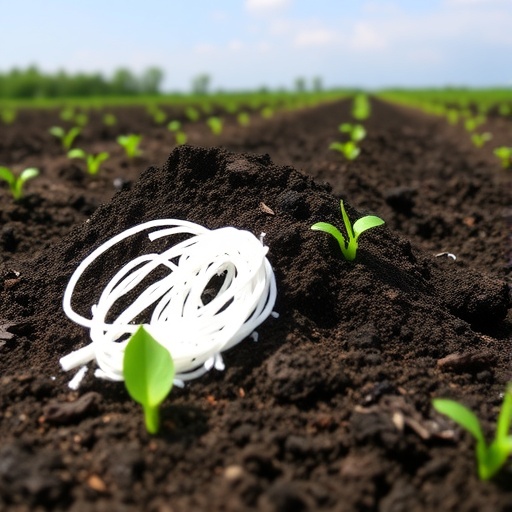In recent years, the environmental impact of per- and polyfluoroalkyl substances (PFAS) has emerged as a pressing issue in ecological research. These synthetic chemicals, notoriously dubbed “forever chemicals” due to their persistent nature in the environment, have garnered widespread attention owing to their potential adverse effects on human health and ecosystems. A recent study by Hazrati et al. seeks to elucidate the intricate relationship between PFAS and soil organic matter, shedding light on the multifaceted dynamics that govern their fate in soils. This research is pivotal in understanding how these contaminants interact with soil constituents, thereby impacting their mobility, bioavailability, and overall environmental persistence.
PFAS have permeated numerous environmental compartments due to their extensive applications across various industries, including firefighting foams, textiles, and food packaging. Their ubiquitous presence raises serious concerns regarding soil and water contamination, prompting scientists to investigate how PFAS congregate and persist within soil matrices. The interaction between PFAS and soil organic matter is particularly significant since organic matter plays a crucial role in the retention and mobility of contaminants in the soil profile. The study by Hazrati and colleagues highlights how the chemical interactions between PFAS and soil organic matter influence the degradation, transport, and bioremediation potential of these pollutants.
Understanding the behavior of PFAS in soil requires a multidisciplinary approach, encompassing chemistry, biology, and environmental science. The researchers employed a variety of analytical techniques to assess the interactions of PFAS with different fractions of soil organic matter. The findings indicate that soil organic matter can significantly affect the sorption of PFAS, thereby altering their environmental fate. This is critical knowledge, as it informs strategies for soil management and remediation efforts aimed at mitigating the risks associated with PFAS contamination.
The study also examines various types of PFAS, including long-chain and short-chain variants, noting that their structural differences lead to distinct environmental behaviors. Long-chain PFAS tend to exhibit stronger interactions with soil organic matter than their shorter-chain counterparts. This variance suggests that remediation strategies need to be tailored according to the specific PFAS involved and their chemical characteristics. By emphasizing the reciprocal nature of the interaction between PFAS and soil organic matter, the authors advocate for comprehensive models that can predict the behavior of PFAS under different environmental conditions.
In addition to elucidating the chemical mechanisms at play, the study underscores the importance of considering biological processes that may influence the transformation of PFAS in soils. Microbial communities present in the soil can play significant roles in degrading or altering these compounds. By exploring the interplay between soil microorganisms and PFAS, researchers could uncover novel bioremediation strategies that harness these natural processes to mitigate PFAS contamination.
The implications of this research extend beyond academic interest, touching on public health and environmental policy. With increasing regulatory scrutiny on PFAS, understanding their behavior in the soil is paramount for developing guidelines aimed at safeguarding groundwater and agricultural systems. Policymakers can benefit from such studies as they navigate the intricacies of managing contaminated lands and ensuring the safety of food supplies.
Moreover, the environmental persistence of PFAS poses a unique challenge for scientists and regulators alike. Traditional remediation methods, such as excavation or chemical treatments, often fall short in addressing the entrenched nature of these contaminants. Through a better understanding of PFAS–soil interactions, innovative solutions can be devised to enhance the efficacy of remediation efforts. The findings from Hazrati et al. pave the way for developing novel materials and methods that can effectively sequester PFAS or accelerate their degradation in contaminated sites.
To comprehend the full extent of the environmental impact of PFAS, it is also essential to consider their transport and fate in connected ecosystems such as rivers and lakes. The behavior of PFAS in these systems can be influenced by soils, indicating a synergistic relationship that warrants further investigation. This interconnectedness highlights the need for integrated environmental monitoring approaches that encompass soil, water, and biotic systems.
As researchers continue to unravel the complexities of PFAS and soil organic matter interactions, it is crucial for public awareness campaigns to educate communities about the potential risks associated with these chemicals. Outreach efforts can help foster better practices regarding the use and disposal of PFAS-containing products, thereby reducing inputs into the terrestrial and aquatic environments.
In conclusion, the recent study conducted by Hazrati, Kumpiene, and Leiviskä signifies a vital leap in understanding the reciprocal influences between PFAS and soil organic matter. By providing insight into the chemical interactions and the potential fate of PFAS in soil systems, this research not only enhances our scientific understanding but also informs policymakers and practitioners in developing effective strategies to combat the pervasive threat posed by PFAS. As the environmental narrative surrounding these substances evolves, it is imperative that continued research integrates various disciplines, ensuring we remain vigilant and proactive in safeguarding our ecosystems and public health.
Subject of Research: Reciprocal influence of per- and polyfluoroalkyl substances (PFAS) and soil organic matter on their fate in soils.
Article Title: Reciprocal influence of per- and polyfluoroalkyl substances (PFAS) and soil organic matter on their fate in soils.
Article References: Hazrati, S., Kumpiene, J., Leiviskä, T. et al. Reciprocal influence of per- and polyfluoroalkyl substances (PFAS) and soil organic matter on their fate in soils. Environ Sci Pollut Res (2025). https://doi.org/10.1007/s11356-025-37024-9
Image Credits: AI Generated
DOI: 10.1007/s11356-025-37024-9
Keywords: PFAS, soil organic matter, environmental impact, contamination, remediation, interactions, bioavailability, transport, persistence.




